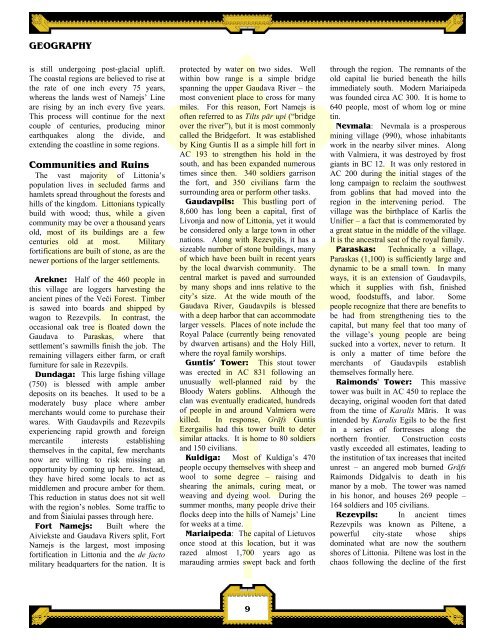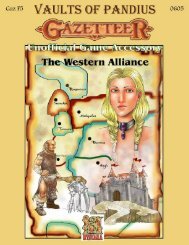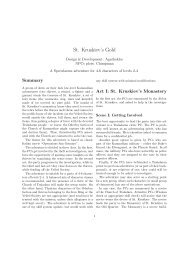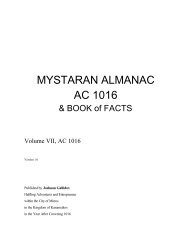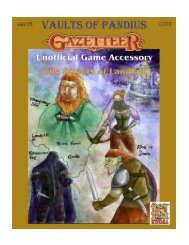The Kingdom of Littonia - Vaults of Pandius
The Kingdom of Littonia - Vaults of Pandius
The Kingdom of Littonia - Vaults of Pandius
You also want an ePaper? Increase the reach of your titles
YUMPU automatically turns print PDFs into web optimized ePapers that Google loves.
GEOGRAPHY<br />
is still undergoing post-glacial uplift.<br />
<strong>The</strong> coastal regions are believed to rise at<br />
the rate <strong>of</strong> one inch every 75 years,<br />
whereas the lands west <strong>of</strong> Namejs’ Line<br />
are rising by an inch every five years.<br />
This process will continue for the next<br />
couple <strong>of</strong> centuries, producing minor<br />
earthquakes along the divide, and<br />
extending the coastline in some regions.<br />
Communities and Ruins<br />
<strong>The</strong> vast majority <strong>of</strong> <strong>Littonia</strong>’s<br />
population lives in secluded farms and<br />
hamlets spread throughout the forests and<br />
hills <strong>of</strong> the kingdom. <strong>Littonia</strong>ns typically<br />
build with wood; thus, while a given<br />
community may be over a thousand years<br />
old, most <strong>of</strong> its buildings are a few<br />
centuries old at most. Military<br />
fortifications are built <strong>of</strong> stone, as are the<br />
newer portions <strong>of</strong> the larger settlements.<br />
Arekne: Half <strong>of</strong> the 460 people in<br />
this village are loggers harvesting the<br />
ancient pines <strong>of</strong> the Veči Forest. Timber<br />
is sawed into boards and shipped by<br />
wagon to Rezevpils. In contrast, the<br />
occasional oak tree is floated down the<br />
Gaudava to Paraskas, where that<br />
settlement’s sawmills finish the job. <strong>The</strong><br />
remaining villagers either farm, or craft<br />
furniture for sale in Rezevpils.<br />
Dundaga: This large fishing village<br />
(750) is blessed with ample amber<br />
deposits on its beaches. It used to be a<br />
moderately busy place where amber<br />
merchants would come to purchase their<br />
wares. With Gaudavpils and Rezevpils<br />
experiencing rapid growth and foreign<br />
mercantile interests establishing<br />
themselves in the capital, few merchants<br />
now are willing to risk missing an<br />
opportunity by coming up here. Instead,<br />
they have hired some locals to act as<br />
middlemen and procure amber for them.<br />
This reduction in status does not sit well<br />
with the region’s nobles. Some traffic to<br />
and from Šiaiulai passes through here.<br />
Fort Namejs: Built where the<br />
Aiviekste and Gaudava Rivers split, Fort<br />
Namejs is the largest, most imposing<br />
fortification in <strong>Littonia</strong> and the de facto<br />
military headquarters for the nation. It is<br />
protected by water on two sides. Well<br />
within bow range is a simple bridge<br />
spanning the upper Gaudava River – the<br />
most convenient place to cross for many<br />
miles. For this reason, Fort Namejs is<br />
<strong>of</strong>ten referred to as Tilts pār upi (“bridge<br />
over the river”), but it is most commonly<br />
called the Bridgefort. It was established<br />
by King Guntis II as a simple hill fort in<br />
AC 193 to strengthen his hold in the<br />
south, and has been expanded numerous<br />
times since then. 340 soldiers garrison<br />
the fort, and 350 civilians farm the<br />
surrounding area or perform other tasks.<br />
Gaudavpils: This bustling port <strong>of</strong><br />
8,600 has long been a capital, first <strong>of</strong><br />
Livonja and now <strong>of</strong> <strong>Littonia</strong>, yet it would<br />
be considered only a large town in other<br />
nations. Along with Rezevpils, it has a<br />
sizeable number <strong>of</strong> stone buildings, many<br />
<strong>of</strong> which have been built in recent years<br />
by the local dwarvish community. <strong>The</strong><br />
central market is paved and surrounded<br />
by many shops and inns relative to the<br />
city’s size. At the wide mouth <strong>of</strong> the<br />
Gaudava River, Gaudavpils is blessed<br />
with a deep harbor that can accommodate<br />
larger vessels. Places <strong>of</strong> note include the<br />
Royal Palace (currently being renovated<br />
by dwarven artisans) and the Holy Hill,<br />
where the royal family worships.<br />
Guntis’ Tower: This stout tower<br />
was erected in AC 831 following an<br />
unusually well-planned raid by the<br />
Bloody Waters goblins. Although the<br />
clan was eventually eradicated, hundreds<br />
<strong>of</strong> people in and around Valmiera were<br />
killed. In response, Grāfs Guntis<br />
Ezergailis had this tower built to deter<br />
similar attacks. It is home to 80 soldiers<br />
and 150 civilians.<br />
Kuldiga: Most <strong>of</strong> Kuldiga’s 470<br />
people occupy themselves with sheep and<br />
wool to some degree – raising and<br />
shearing the animals, curing meat, or<br />
weaving and dyeing wool. During the<br />
summer months, many people drive their<br />
flocks deep into the hills <strong>of</strong> Namejs’ Line<br />
for weeks at a time.<br />
Mariaipeda: <strong>The</strong> capital <strong>of</strong> Lietuvos<br />
once stood at this location, but it was<br />
razed almost 1,700 years ago as<br />
marauding armies swept back and forth<br />
9<br />
through the region. <strong>The</strong> remnants <strong>of</strong> the<br />
old capital lie buried beneath the hills<br />
immediately south. Modern Mariaipeda<br />
was founded circa AC 300. It is home to<br />
640 people, most <strong>of</strong> whom log or mine<br />
tin.<br />
Nevmala: Nevmala is a prosperous<br />
mining village (990), whose inhabitants<br />
work in the nearby silver mines. Along<br />
with Valmiera, it was destroyed by frost<br />
giants in BC 12. It was only restored in<br />
AC 200 during the initial stages <strong>of</strong> the<br />
long campaign to reclaim the southwest<br />
from goblins that had moved into the<br />
region in the intervening period. <strong>The</strong><br />
village was the birthplace <strong>of</strong> Karlis the<br />
Unifier – a fact that is commemorated by<br />
a great statue in the middle <strong>of</strong> the village.<br />
It is the ancestral seat <strong>of</strong> the royal family.<br />
Paraskas: Technically a village,<br />
Paraskas (1,100) is sufficiently large and<br />
dynamic to be a small town. In many<br />
ways, it is an extension <strong>of</strong> Gaudavpils,<br />
which it supplies with fish, finished<br />
wood, foodstuffs, and labor. Some<br />
people recognize that there are benefits to<br />
be had from strengthening ties to the<br />
capital, but many feel that too many <strong>of</strong><br />
the village’s young people are being<br />
sucked into a vortex, never to return. It<br />
is only a matter <strong>of</strong> time before the<br />
merchants <strong>of</strong> Gaudavpils establish<br />
themselves formally here.<br />
Raimonds' Tower: This massive<br />
tower was built in AC 450 to replace the<br />
decaying, original wooden fort that dated<br />
from the time <strong>of</strong> Karalis Māris. It was<br />
intended by Karalis Egils to be the first<br />
in a series <strong>of</strong> fortresses along the<br />
northern frontier. Construction costs<br />
vastly exceeded all estimates, leading to<br />
the institution <strong>of</strong> tax increases that incited<br />
unrest – an angered mob burned Grāfs<br />
Raimonds Didgalvis to death in his<br />
manor by a mob. <strong>The</strong> tower was named<br />
in his honor, and houses 269 people –<br />
164 soldiers and 105 civilians.<br />
Rezevpils: In ancient times<br />
Rezevpils was known as Piltene, a<br />
powerful city-state whose ships<br />
dominated what are now the southern<br />
shores <strong>of</strong> <strong>Littonia</strong>. Piltene was lost in the<br />
chaos following the decline <strong>of</strong> the first


